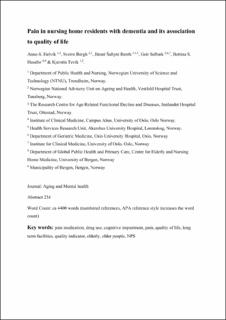Pain in nursing home residents with dementia and its association to quality of life
Helvik, Anne-Sofie; Bergh, Sverre; Šaltytė Benth, Jūratė; Selbæk, Geir; Husebø, Bettina Elisabeth Franziska; Tevik, Kjerstin Elisabeth
Peer reviewed, Journal article
Accepted version

Åpne
Permanent lenke
https://hdl.handle.net/11250/3001032Utgivelsesdato
2021Metadata
Vis full innførselSamlinger
Sammendrag
Abstract Objectives We aimed to describe pain, use of analgesics and quality of life (QoL) in people with dementia admitted to a Norwegian nursing home (NH), and to explore if and how pain was associated with their QoL when adjusting for sociodemographic characteristics, other health conditions and use of analgesics. Method A total of 953 Norwegian NH residents with dementia (mean age 84.0, SD 7.5 years, 35.8% men) were included at admission to the NH. Pain and QoL were assessed using the Mobilization-Observation-Behavior-Intensity-Dementia-2 (MOBID-2) Pain Scale and the Quality of Life in Late-Stage Dementia (QUALID) scale, respectively. Severity of dementia, personal level of activities of daily living, general medical health, neuropsychiatric symptoms, and the use of psychotropic drugs and analgesics were assessed. Results In total, 36% of the participants had clinically relevant pain intensity (MOBID-2 ≥ 3) and 52% received analgesics. Paracetamol was most frequently prescribed (45%). In an adjusted linear mixed model, more severe pain was associated with higher QUALID total scores, indicating poorer QoL (regression coefficient 0.52, 95% CI 0.36-0.69). Conclusion Pain prevalence at NH admission was high in residents with dementia; half used analgesics, particularly paracetamol. More severe pain was associated with poorer QoL when adjusting for sociodemographic characteristics, other health conditions, and use of analgesics. The routine assessment of pain at NH admission can uncover undiagnosed and untreated pain and allow for adequate non-pharmacological and pharmacological pain management and likely increased QoL.